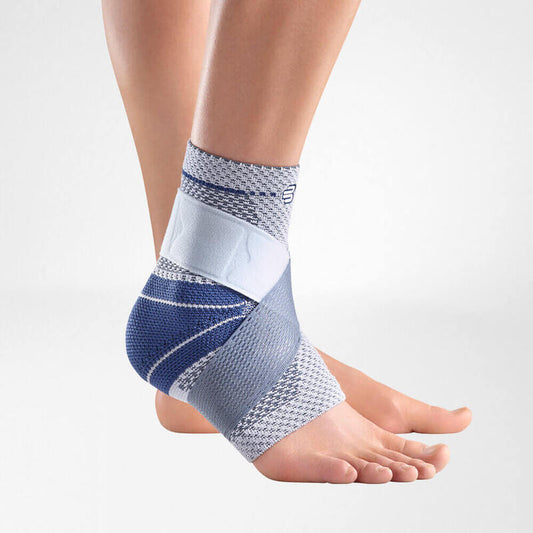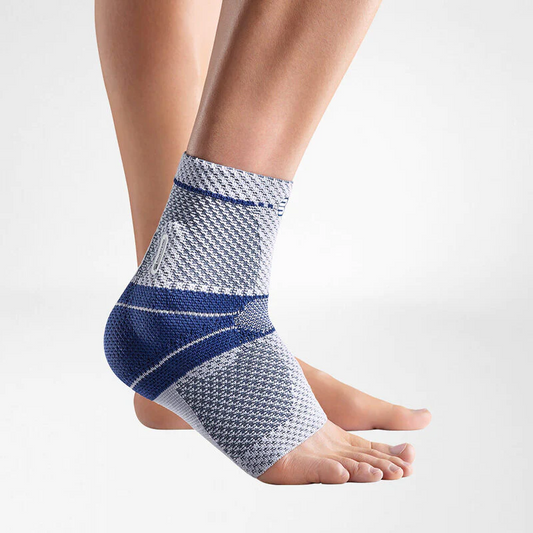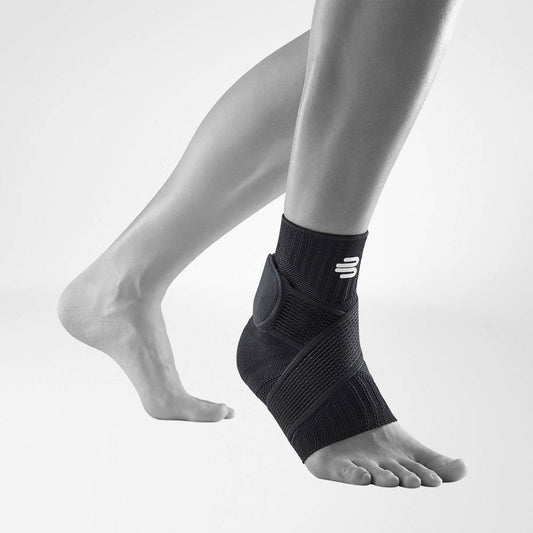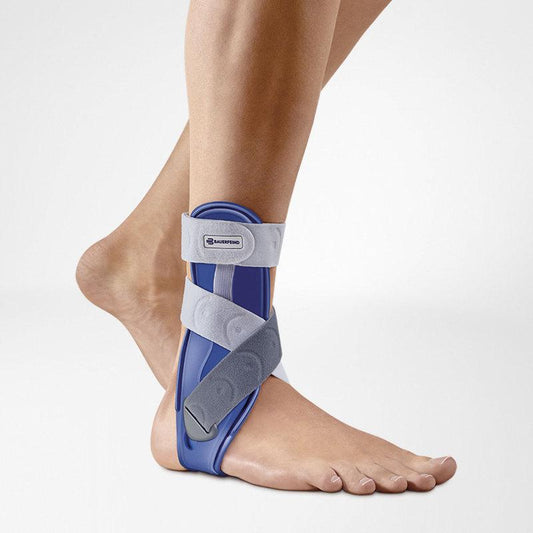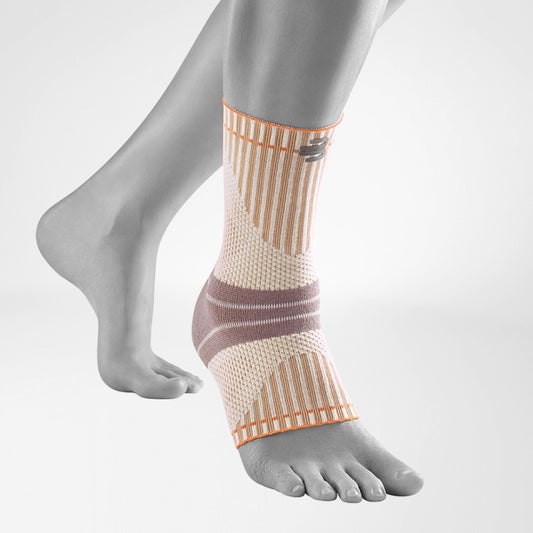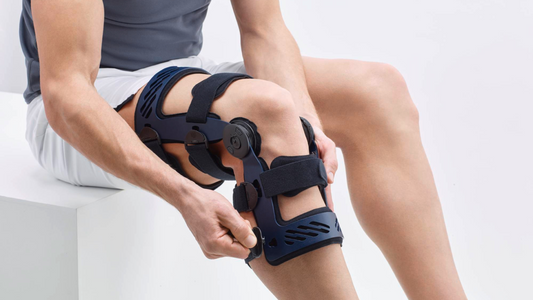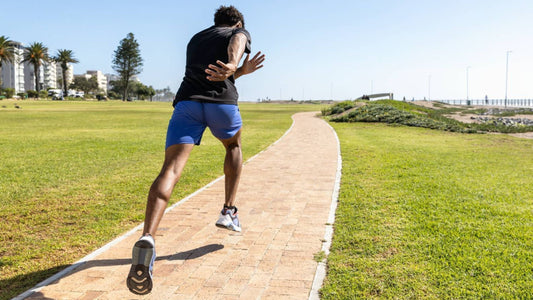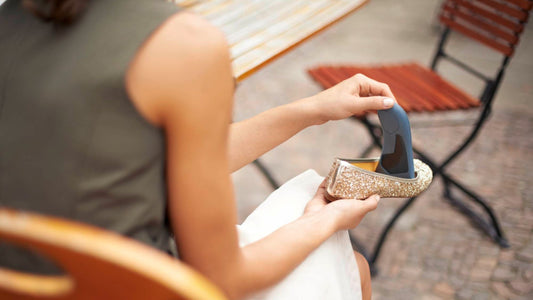Brief overview of chronic ankle instability (CAI)
Chronic Ankle Instability (CAI) is a term for stability issues or insufficiencies after an ankle injury. Typically, CAI develops due to laxity or injury in the ligaments (anterior talofibular ligament (ATFL), the calcaneofibular ligament (CFL) and/or the posterior talofibular ligament (PTFL), resulting in them being unable to support the joint properly. Ligament injuries become classified as CAI if the patient continues exhibiting a propensity for recurrent ankle sprains, frequent episodes of the ankle giving way, persistent pain, swelling, reduced ROM, weakness, and diminished self-reported function for 12 months after symptom onset.
Importance of understanding and managing ankle sprains, tears, and CAI
It is estimated that 20% of patients with an ankle sprain will develop CAI, with some sources suggesting the number is as high as 40%. Following an ankle sprain, patients often experience a loss in proprioception, strength, and postural control. If left untreated or managed poorly, these issues can eventually culminate in CAI. It’s essential to assess and address ligament injury or insufficiency early. Poor joint mechanics stemming from instability can damage ankle structures like tendons, bones, and cartilage. Additionally, early intervention through conservative methods like bracing and physical therapy can reduce the need for surgery (though some cases may still require it).
Prevalence of Ankle Instability
According to nps.org, Sports Medicine Australia, and Herzog et al.:
- Around 230,000 Australians see their GP for an ankle sprain each year
- They constitute around 5% of emergency department visits and 15% of sporting injuries
- Around 50% of hospitalised cases occur outside of sport
- Women are nearly twice as likely to sprain their ankles than men (13.6 vs 6.9/1000)
- Acute ankle sprains are more common in teenagers and children than in adults
In 70% of these cases, the patient will experience some form of disability for up to 2 years after the initial injury.
In up to 40% of cases, whether due to insufficient recovery, joint changes, or other factors, a sprain becomes CAI.
Common Causes of Ankle Instability
Chronic ankle instability stems from ankle sprains, which various factors can cause.
- Ligament laxity owing to the patient’s natural biomechanics or a medical condition such as hypermobility syndrome, Ehlers-Danlos syndrome, Marfan syndrome, bony dysplasia, or osteoarthritis.
- Muscle weakness or imbalance (particularly in the peroneal muscle) increases the risk of the ankle giving out in sports or even daily activities.
- Sporting injury. Ankle sprains are especially common in basketball, soccer, and netball.
- Improper rehabilitation following injury. Ankle sprains can become chronic if the patient or athlete doesn’t follow proper rehabilitative methods. Initially, these may include bracing, physical therapy, and pausing sporting activities that may re-injure the ankle. In some cases, surgery may be required.
Sports and Activities Leading to Ankle Instability
Sports are one of the key risk factors for chronic ankle instability due to a high incidence of sprain and recurrence. Sports among the most likely to cause the condition include but aren’t limited to:
- Netball - ⅘ players sustain an ankle sprain, and 50% of these will have a recurrence
- Basketball - 85% of female players with prior ankle injury develop CAI
- Soccer - 29.41% of all injuries are ankle ligament injuries
- Volleyball - 44.1% of game injuries and 29.4% of practice injuries are ankle sprains
46% of acute ankle sprains in volleyball, 28% in basketball, and 19% in soccer were recurrent injuries.
According to cohort studies and meta-analyses on these sports, the high incidence rate is due to sprinting, pivoting, cutting, jumping, and landing, which place significant stress on the ankle. Poor loading mechanics and player contact also contribute, as can functional strength asymmetries and increased BMI. Level of play is also a factor, with pro athletes often training and playing at a higher intensity than amateur players.
Some studies suggest that the high recurrence rate is likely due to players not commonly being referred to GPs or other health professionals, not undertaking adequate rehabilitation, and almost immediately returning to play and training following their ankle sprain.
While shown to be effective, prevention and treatment strategies like external supports and preventative ankle exercises often aren’t properly implemented or adhered to.
Management Techniques for Ankle Instability
Importance of early intervention
Ankle instability can have a cascade effect on overall health and mobility. It can lead to post-traumatic arthritis in the affected leg, reduced range of motion, long-term pain, and secondary tissue injury. Hence, it is essential to properly address a sprain before it develops into CAI and to treat CAI - whether conservatively or surgically - before the condition further damages the joint.
It’s also important to note that conservative therapies should be the first line of defence. Surgical intervention is generally only recommended when bracing and taping have failed.
Neuromuscular and proprioceptive training are also essential. In addition to the proprioceptive benefits of compression bracing, the patient should undergo physio rehab via stability exercises.

Rehabilitation exercises
Certain studies demonstrate the importance of combining strength and proprioceptive training in CAI rehabilitation. Some of the key recommended exercises include:
Single leg stance
The exercise aims to improve proprioception and balance. Your patient should stand on one leg for as long as possible without holding onto any support.
Single-leg reach/catch
This exercise is an advanced variation of the single-leg stance, challenging coordination.
- In the reach, the patient should stand on one leg and extend the other, tapping points on the floor in a wide circle around themselves.
- In the catch, the patient can stand on one leg while bouncing a ball off a wall and catching it or tossing a ball back and forth with a friend or family member.
Resisted flexion, extension, inversion, eversion
Moving the ankle through its range of motion under strain will strengthen key muscle groups responsible for stability, including the peroneus brevis, longus, EDL, tibialis anterior, and posterior tibialis.
- The patient should loop one end of the resistance band around their foot and the other around an anchor point.
- They should flex, extend, invert, and evert the foot in the opposite direction of the band.
Heel drops/calf raises
These exercises strengthen the calves (gastrocnemius and soleus), which are crucial to ankle stability.
For heel drops, the patient should stand on a ledge with their heels hanging off. Only the balls of their feet should be on the ledge. For comfort, it is advised to do the exercise on a slightly soft or rounded surface, like a carpeted stair.
- Once in position, they can hold onto a support structure and slowly drop their heels to the extent of their full ROM.
- They should hold the position for a few seconds, then slowly raise their heels to the level of the step.
For calf raises, the patient should stand on a flat surface. For comfort, they can hold onto a support structure and stand on a mat, preferably barefoot. They should slowly raise themselves onto their toes to the full ROM and slowly bring themselves back down without letting their heels touch the floor.
Marble pick up/towel scrunch
This exercise aims to strengthen the intrinsic muscles supporting the arch.
- Instruct the patient to put a towel or some marbles on the floor.
- With the towel, they should keep their heels on the floor and scrunch the towel towards themselves using their toes.
- With the marbles, they can use their toes to pick up one marble at a time and put it back into the container.
- They should continue the exercise for at least 2 minutes.
Lifestyle changes to support ankle health
The patient needs to take measures to support the ankle to prevent sprains, recurrent sprains, and CAI. Such measures apply to everyone, though they are essential for the demographics most prone to ankle injury, including children, teenagers, women, and athletes.
- Regular balance training and muscle-strengthening exercises.
- Diet. A sufficient intake of omega-3 fatty acids, vitamin D, and vitamin K will maintain healthy circulation, collagen synthesis, and muscle strength and recovery.
- Warm up before exercise and cool down after to prepare the joints and muscles for exercise and reduce stiffness.
- See a physiotherapist, osteopath, or other health professional following an ankle sprain, which is important for a tailored recovery plan and advice.
- Per a clinician’s instruction, taking precautions in or avoiding sporting activities following a sprain or with existing instability or laxity.
- Doing sport in a sports ankle support (compression with a strap). As re-spraining the ankle is extremely common among athletes, sports support can be instrumental in improving proprioception and stability without restricting ROM.
The Role of Bracing in Prevention and Management

MalleoTrain Plus
Research shows bracing is an effective conservative method for ankle sprains and CAI. At Bauerfeind, we offer a wide range of ankle supports, sleeves, and braces to suit all stages of recovery. One systematic review found that bracing resulted in better functional outcomes than other conservative treatment methods. Some studies in the review also suggested that bracing is generally more cost-effective.
Splint brace for ankle instability
Splints or rigid ankle braces are best suited for acute sprains and more severe cases of chronic ankle instability.
For instance, one study found that the MalleoLoc Ankle Splint reduced damaging supination movements and allowed regular walking mechanics in patients with lateral ankle instability. It achieves this through a splint and secure figure-8 straps.
The MalleoLoc is also ideal for non-surgical treatment of injuries to the capsular ligament complex, post-operative protection, and chronic ligament insufficiency.
Other notable options include the AirLoc Ankle Brace, which may be more comfortable than the MalleoLoc for patients with foot conditions such as plantar fasciitis as its splints don’t go under the foot. The MalleoLoc L3, meanwhile, can be beneficial for swelling, lateral ligament ruptures, and proprioceptive/sensorimotor deficits as it combines the MalleoLoc’s splint and strap system with medical-grade compression knit.
Ankle compression supports for instability
Compressive supports can help prevent sprains, minimise the risk of recurrence, and facilitate the patient’s return to sport. According to one case study, football player Jan Wörnhard and uni hockey player Ladina Sgier wore the MalleoTrain Plus and MalleoTrain S during their recoveries from upper ankle injuries and subsequent chronic instability.
These supports incorporate medical-grade compression and a figure-8 strap to improve sensorimotor function and proprioception and stabilise the ankle. The MalleoTrain Plus also features two patented pads that assist with pain relief and swelling reduction. While these braces aren’t ideal for the initial stages of injury or in severe cases of instability, the case studies show they can be great assets in an athlete's return to sport.
Conclusion
Chronic ankle instability is a condition commonly stemming from ankle ligament injuries. As it can lead to chronic pain, damage to surrounding structures, and even osteoarthritis, it’s essential to help patients manage the condition through bracing, physical therapy, and certain lifestyle changes. Ideally, the treatment process should begin right after an acute sprain to prevent recurrence and lower the risk of the associated instability becoming chronic.


